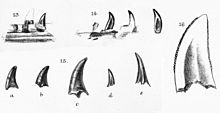Nuthetes
| Nuthetes | |
|---|---|

| |
| Portions of the holotype mandible and close up of a tooth | |
| Scientific classification | |
| Domain: | Eukaryota |
| Kingdom: | Animalia |
| Phylum: | Chordata |
| Clade: | Dinosauria |
| Clade: | Saurischia |
| Clade: | Theropoda |
| Family: | †Dromaeosauridae |
| Clade: | †Eudromaeosauria |
| Subfamily: | †Velociraptorinae |
| Genus: | †Nuthetes Owen, 1854 |
| Species: | †N. destructor
|
| Binomial name | |
| †Nuthetes destructor Owen, 1854
| |
| Synonyms | |
| |
Nuthetes is the name given to a
Discovery and naming

The
The genus Nuthetes contains one species (the type species), Nuthetes destructor. N. destructor was named and described by Richard Owen in 1854.[6] The generic name Nuthetes is derived from the Koine Greek nouthetes, a contraction of νουθέτητης (nouthetetes) meaning "one who admonishes" or "a monitor," in reference to the similarity of Nuthetes teeth to those of a modern monitor lizard.[7] The specific name is Latin for "destroyer", a reference to "the adaptations of the teeth for piercing, cutting, and lacerating the prey" of a form he estimated to be equal in size to the present Bengal monitor.[8]
Classification

Nuthetes was originally classified by Owen as a
According to Milner, Nuthetes can be diagnosed for having a tooth denticle size difference index ranging from 1-14 to 1-55.[13]
See also
References
- .
- .
- ^ Pouech, J.; Mazin, J. M.; Billon-Bruyat, J. P. (2006). "Microvertebrate biodiversity from Cherves-De-Cognac (Lower Cretaceous, Berriasian: Charente, France)". Mesozoic Terrestrial Ecosystems: 96–100.
- ^ Bonde, N. (2012). "Danish Dinosaurs: A Review". In Godefroit, P. (ed.). Bernissart Dinosaurs. Indiana University Press. pp. 435–449.
- ^ Ronan Allain, Romain Vullo, Lee Rozada, Jérémy Anquetin, Renaud Bourgeais, et al.. Vertebrate paleobiodiversity of the Early Cretaceous (Berriasian) Angeac-Charente Lagerstätte (southwestern France): implications for continental faunal turnover at the J/K boundary. Geodiversitas, Museum National d’Histoire Naturelle Paris, In press. ffhal-03264773f
- S2CID 130752835.
- ISBN 978-0-7864-1166-5.
- ^ Owen, R. (1873). "Monograph on the fossil Reptilia of the Wealden and Purbeck formations". The Palaeontographical Society. supp. 5: 31–39.
- ^ Owen, R. (1878). "Monograph on the fossil Reptilia of the Wealden and Purbeck formations". The Palaeontographical Society. supp. 8: 1–19.
- ^ Milner, A. C. (2002). "Theropod dinosaurs of the Purbeck Limestone Group, southern England". Special Papers in Palaeontology. 68: 191–201.
- .
- .
- ^ Milner, A. C. (2002). "Theropod dinosaurs of the Purbeck Limestone Group, southern England". Special Papers in Palaeontology. 68: 191–201.
External links
- Extensive description from the Milner paper, on the Dinosaur Mailing List.
